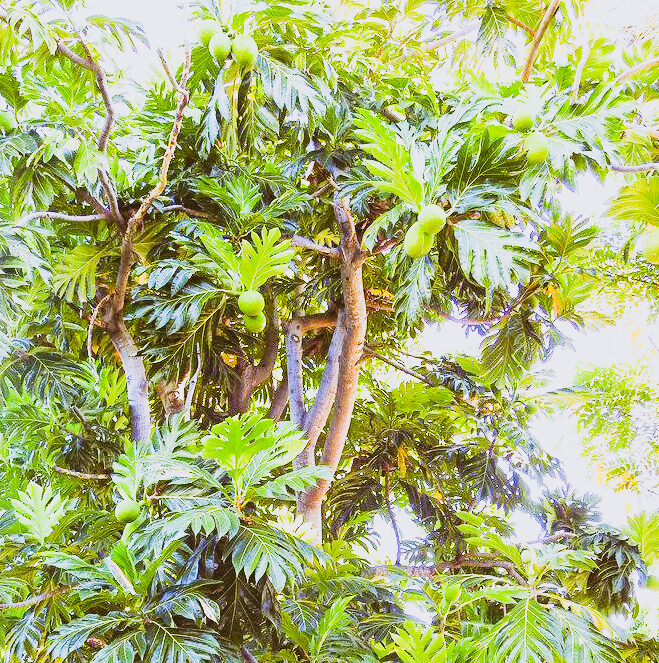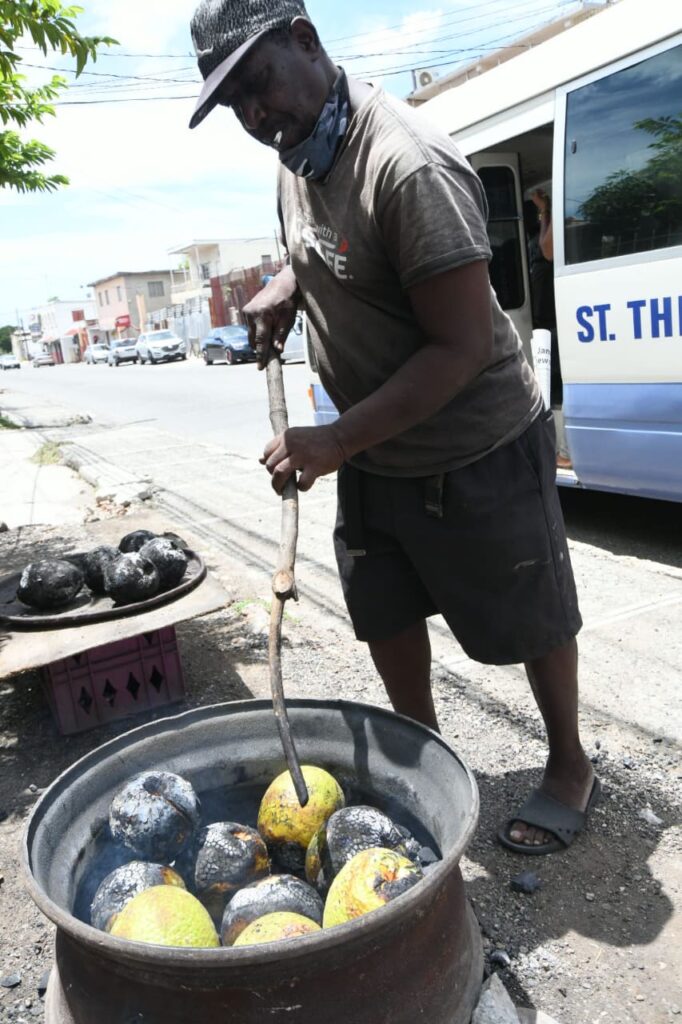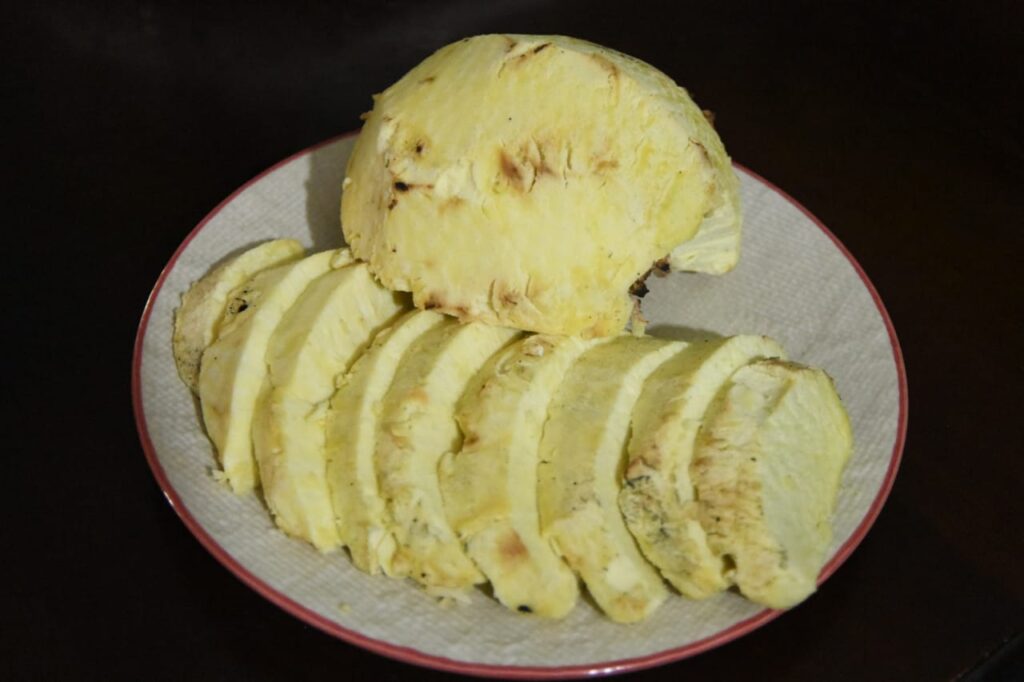
Back in the 1950’s there were more breadfruit trees in Jamaica than people. With the population hovering around 1.5 million in the 1950’s, there were about 2.3 million breadfruit trees on the Island.
However, the shift to a more urban lifestyle over the decades, meant that women who worked outside of the home became too busy to invest the time to prepare the fruit, by roasting or baking. Besides, taste buds were getting used to imported rice and by-products of wheat and corn, which were easier to prepare.

Breadfruit’s popularity took a dive, and by 1986, there were fewer than 50,000 breadfruit trees in production.
Breadfruit, that dimpled green orb, is a native of Papua New Guinea and was brought to the south Pacific by explorers. It arrived in Jamaica via Tahiti, and courtesy of Captain William Bligh in the late 18th century. His first attempt was thwarted by the most famous maritime mutiny on HMS Bounty, when he lost all the plants.
Five years later, Bligh succeeded in bringing breadfruit to the West Indies, touting it as an inexpensive way to feed slaves on sugar plantations. About 600 saplings were planted in Bath, St. Thomas and Westmoreland.
With more than 150 known varieties, breadfruit is an important starch. Whether round, oblong or oval, white or yellow heart, a breadfruit which typically weighs four to six pounds, can provide the carbohydrate portion of a meal for a family of six.
Loaded with vitamins
No longer despised as slave food, breadfruit has earned its place among exotic Jamaican foods. Literally bread growing on trees, it is a popular accompaniment for Jamaica’s national dish of ackee and salt-fish, baked, roasted or fried. Versatile breadfruit can be paired with meats, curries and other options, over breakfast, lunch or dinner.
Many people know that breadfruit is loaded with carbohydrates and fiber which makes it a diabetic-friendly food. Kingston-based Nutritionist Dr. Dawn Stephenson puts it this way: “It’s a nutritious food with an extensive array of vitamins and minerals and also has anti-inflammatory properties.”
St. Thomas, where breadfruit first made its entry, is now the epicenter of the fruit’s resurgence. Source Farm Ecovillage Community Development Institute in St. Thomas, is ensuring the viability of breadfruit by working in tandem with “Trees That Feed Foundation” (TTFF) to convince investors that growing breadfruit is a good business decision and one that protects the environment.
Established in 2008, TTFF is an NGO dedicated to addressing nutritional needs in developing countries. One of its key partners is the Breadfruit Institute in Hawaii, which does extensive research on the fruit. TTFF supplies hardened field-ready saplings to farmers and community groups in Jamaica and 17 other developing countries. It is completely understandable that TTFF selected breadfruit as the first crop to distribute because it is one of earth’s highest yielding crops. More than 80,000 saplings have been distributed in Jamaica.
History Notes
- British mariner William Bligh was authorized by King George 111 to undertake a breadfruit- expedition mission to Tahiti on HMS Bounty in 1788.
- Captain Bligh set sail from Tahiti in 1789 with 1,015 fledging breadfruit plants heading to the West Indies. Breadfruit, found to be nutritious and cheap, would form part of the slaves’ diet.
- Three weeks into the voyage, April 1789, there was a mutiny on HMS Bounty – the breadfruit plants were thrown overboard and Bligh set adrift on the Bounty’s launch.
- Bligh survived and was declared a hero when he returned to Britain. He was promoted and lead a return mission to Tahiti on HMS Providence.
- On his second attempt, Captain Bligh collected 2,126 breadfruit plants of five varieties from Tahiti and set sail for the West Indies– the plants were stored in pots and tubs on deck and a nursery below. Some of the breadfruit plants were delivered to St. Vincent.
- February 5, 1793, HMS Providence docked at Port Royal with 678 breadfruit trees.
- Bath Botanical Gardens in St. Thomas received 66 of the breadfruit trees.
- Bath is one of the oldest Botanical Gardens in the world.
- Breadfruit plants were delivered to Bluefields, Westmoreland and various other parts of the island.
- The story of the mutiny on HMS Bounty is well documented has been immortalized in various films and novels.
“In the absence of good data on yield, farmers, food processors and distributors are reluctant to invest in breadfruit agribusiness. The economics are uncertain and the risks unacceptable. This project is intended to reduce the uncertainty and risk,” promises Nicola Shirley-Phillips, Director at Source Farm Ecovillage Community Development Institute.
A mature tree can produce 250 to 300 breadfruits, that’s half a ton of food per year. In an orchard setting, planted at a density of 35 to 40 trees per acre, breadfruit out-produces all other tropical starch crops, yielding upwards of 18 tons of fruit annually.
There’s however, one draw-back with breadfruit – it’s short shelf life. Mrs. Philips has the solution. “We recommend drying and processing excess fruit into chips or flour. The processed fruit has a shelf life measured in months or years.”
She reports that entrepreneurs and community groups have been assisted to successfully produce breadfruit flour for the local market.
“We see the potential to substantially reduce hunger and dependence on expensive imported corn, rice and wheat,” Phillips said.
Indeed, world attention has been focused on the breadfruit, after it was identified as a superfood with the potential to alleviate world hunger. It’s a fast-growing perennial, not labour intensive and does not require much fertilizer or potentially harmful pesticides.
Breadfruit doesn’t grow from seeds and traditional methods of propagation are slow and often unreliable. Improved techniques of propagation have increased the supply of saplings. It grows well in hot, humid conditions and is adaptable to a wide range of soil types and is low maintenance.
Breadfruit is bouncing back in a big way and its gluten-free status has placed it in the category of superfoods. The fruit is available in various farmers’ markets and grocery outlets, roasted or baked and ready to be plated. That aside, breadfruit is also being presented in vacuum-sealed packages and also canned.

There is no dispute about it: breadfruit is a healthy food and its potential to become a 21st Century beacon of hope is enormous.
Breadfruit Lore
- To ease a toothache, eat the roasted breadfruit flower.
- Apply the leaf of the breadfruit on the tongue to help cure thrush
- Breadfruit conditions the hair and discourages breakage as it is a good source of omega 3 and omega 6 fatty acids
- Tree latex can be used to treat hernia in children
- Juice of the leaf is used as eardrops
- Powder of the roasted leaf used to treat enlarged spleen
- Crushed flesh is used to make a poultice to treat tumors
- Ashes of burnt leaves can be used to treat skin infections.
- Tree latex can be bandaged on the spine to relieve sciatica.
- Diluted latex can be ingested to treat diarrhea.
This article was very informative, I never knew this rich history of the breadfruit! Being a diabetic the breadfruit has become my favorite starch as it keeps the blood sugar level in check!
It’s very expensive to buy a breadfruit here in the US & there is no certainty that it’s going to be wholesome! I would like to know more of how I could purchase the vacuum packed breadfruit,
Hi the breadfruit flour brand Carita is carried in Jamaican grocery stores you may want to ask your local West Indian stores to get it.
A very well researched and informative article. The historical background makes it fascinating for the reader to understand the origin of this very versatile food that many of us enjoy consuming .
This is a good article. It has reinforced the views that I have held about the importance of breadfruit in our diet and has brought the ongoing research into breadfruit to the fore. Well done. Looking forward to more articles of this nature.
Interesting, informative, and well researched article. The breadfruit continues to occupy a revered status in my diet. It has moved from the status of “poor people food” during my childhood to “exotic fruit” now in my adulthood. It takes much of an effort for me to find a really good Jamaican breadfruit here. I am sure that there is a lucrative export market here. I am going to pass on this article to some of my friends here. It makes a very good read.
This is so well researched feature from which I learnt so much. Thanks for using your writing and editorial skills to prepare this article and for launching a great website which is has a clear, crisp layout. Well done.
Delightful article with an interesting history lesson about the Breadfruit tree… a joy to read.
Very informative and interesting article. I have started buying roasted breadfruit instead of bread. I liked it with ackee & saltfish or anything for that matter. Much healthier. (I discovered this website after hearing Ms. Gager on RJR’s Long Bench).
Very informative and interesting article. I have started buying roasted breadfruit instead of bread. I like it with ackee & saltfish or anything for that matter. Much healthier. (I discovered this website after hearing Ms. Gager on RJR’s Long Bench).